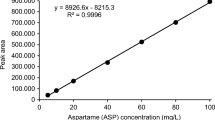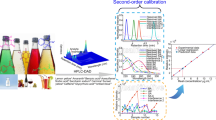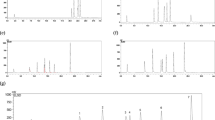Abstract
A new, fast and efficient method was developed for the separation and simultaneous quantification of acesulfame-K, aspartame, cyclamate, neotame and saccharin in food by ultra-performance liquid chromatography (UPLC) and diode array detector (DAD). Univariate strategies were applied for the optimisation of mobile phase pH, proportion of solvents in the mobile phase, flow rate and column temperature. Multivariate techniques were used for the simultaneous optimisation of 13 responses applying the Derringer and Suich desirability function. Many of the models presented lack of fit. However, it was possible to optimise the method using strategies for the restriction of the region to be investigated by the algorithm used in the desirability function. The optimised method was validated and applied to nine food matrices (soft drink, nectar, juice, ready-to-drink tea, jam, barbecue sauce, tomato sauce, instant juice and instant pudding), presenting good resolution, rapid analysis (11 min) and low use of reagents. This indicates that the UPLC is an excellent alternative for the simultaneous analysis of artificial sweeteners in foods.


Similar content being viewed by others
References
Abhilash M, Paul MVS, Varghese MV, Nair RH (2011) Effect of long term intake of aspartame on antioxidant defense status in liver. Food Chem Toxicol 49:1203–1207. doi:10.1016/j.fct.2011.02.019
Ballus CA, Meinhart AD, Bruns RE, Godoy HT (2011) Use of multivariate statistical techniques to optimize the simultaneous separation of 13 phenolic compounds from extra-virgin olive oil by capillary electrophoresis. Talanta 83:1181–1187. doi:10.1016/j.talanta.2010.07.013
Ballus CA, Meinhart AD, de Souza Campos FA Jr, Bruns RE, Godoy HT (2014) Doehlert design-desirability function multi-criteria optimal separation of 17 phenolic compounds from extra-virgin olive oil by capillary zone electrophoresis. Food Chem 146:558–568
Bergamo AB, Silva JAF, Jesus DP (2011) Simultaneous determination of aspartame, cyclamate, saccharin and acesulfame-K in soft drinks and tabletop sweetener formulations by capillary electrophoresis with capacitively coupled contactless conductivity detection. Food Chem 124:1714–1717. doi:10.1016/j.foodchem.2010.07.107
Brasil (1998) Regulamento técnico referente a alimentos para fins especiais vol portaria n. 29, de 13 de janeiro de 1998 poder executivo, diário oficial da união
Brasil (2008) Regulamento técnico que autoriza o uso de aditivos edulcorantes em alimentos, com seus respectivos limites máximos vol Resolução RDC n. 18 de 24 de março de 2008. Poder executivo, diário oficial da união
Breitkreitz MC, Jardim IC, Bruns RE (2009) Combined column-mobile phase mixture statistical design optimization of high-performance liquid chromatographic analysis of multicomponent systems. J Chromatogr A 1216:1439–1449. doi:10.1016/j.chroma.2008.12.093
Chen Q-c, Mou S-f, Liu K-n, Yang Z-y, Ni Z-m (1997) Separation and determination of four artificial sweeteners and citric acid by high-performance anion-exchange chromatography. J Chromatogr A 771:135–143
Chesnut SM, Salisbury JJ (2007) The role of UHPLC in pharmaceutical development. J Sep Sci 30:1183–1190. doi:10.1002/jssc.200600505
Cuq B, Rondet E, Abecassis J (2011) Food powders engineering, between knowhow and science: constraints, stakes and opportunities. Powder Technol 208:244–251. doi:10.1016/j.powtec.2010.08.012
Demiralay EÇ, Özkan G, Guzel-Seydim Z (2006) Isocratic separation of some food additives by reversed phase liquid. Chromatogr Chromatographia 63:215–219. doi:10.1365/s10337-005-0683-8
Derringer G, Suich R (1980) Simultaneous optimization of several responses variables. J Qual Technol 12:214–219
Dossi N, Toniolo R, Susmel S, Pizzariello A, Bontempelli G (2006) Simultaneous RP-LC determination of additives in soft drinks. Chromatographia 63:557–562. doi:10.1365/s10337-006-0793-y
Gumustas M, Kurbanoglu S, Uslu B, Ozkan SA (2013) UPLC versus HPLC on drug analysis: advantageous, applications and their validation. Parameters 76:1365–1427. doi:10.1007/s10337-013-2477-8
Horie M, Ishikawa F, Oishi M, Shindo T, Yasui A, Ito K (2007) Rapid determination of cyclamate in foods by solid-phase extraction and capillary electrophoresis. J Chromatogr A 1154:423–428. doi:10.1016/j.chroma.2007.03.094
Ji C, Sun Y, Li X, Chu X, Chen Z (2009) Simultaneous determination of artificial sweeteners in beverage by ultra performance liquid. Chromatogr Sepu 27:111–113
Lawrence J, Charboneau C (1988) Determination of seven artificial sweeteners in diet food preparation. J Assoc Off Anal Chem 71:934–937
Nabors LO (2001) Alternative Sweeteners. Marcel Dekker, Switzerland
Prasad OM, Rai G (1987) Haematological abnormalities induced by feeding a common artificial sweetener, saccharin, in icr swiss mice. Toxicol Lett 36:81–88
Siouffi A-M (2000) HPLC. In: Nollet LML (ed) Food Analysis by HPLC, 2nd edn. Marcel Dekker, Inc., New York, p 1049
Thompson M, Ellison SLR, Wood R (2002) Harmonized guidelines for single laboratory validation of methods of analysis. IUPAC 74:835–855
Wasik A, McCourt J, Buchgraber M (2007) Simultaneous determination of nine intense sweeteners in foodstuffs by high performance liquid chromatography and evaporative light scattering detection—development and single-laboratory validation. J Chromatogr A 1157:187–196. doi:10.1016/j.chroma.2007.04.068
Witt J (1999) Discovery and developmente of Neotame. In: CORTI A (ed) Low-calorie sweeteners: Present and Future., vol 85. World Review of Nutrition and Dietetics, vol 85. A. P. Simopoulus, Barcelona, pp 52–57
Yang DJ, Chen B (2009) Simultaneous determination of nonnutritive sweeteners in foods by HPLC/ESI-MS. J Agric Food Chem 57:3022–3027. doi:10.1021/jf803988u
Zecevic M, Jocic B, Zivanovic L, Protic A (2008) Application of multicriteria methodology in the development of improved RP-LC-DAD for determination of rizatriptan and its degradation products. Chromatographia 68:911–918. doi:10.1365/s10337-008-0823-z
Zhao Y-G, Chen X-H, Yao S-S, Pan S-D, Li X-P, Jin M-C (2012) Analysis of nine food additives in red wine by ion-suppression reversed-phase high-performance liquid chromatography using trifluoroacetic acid and ammonium acetate as ion-suppressors. Anal Sci 28:967–971
Zhu Y, Guo Y, Ye M, James FS (2005) Separation and simultaneous determination of four artificial sweeteners in food and beverages by ion chromatography. J Chromatogr A 1085:143–146. doi:10.1016/j.chroma.2004.12.042
Zygler A, Wasik A, Namieśnik J (2009) Analytical methodologies for determination of artificial sweeteners in foodstuffs. TrAC Trends Anal Chem 28:1082–1102. doi:10.1016/j.trac.2009.06.008
Acknowledgments
The authors are grateful to Sweetmix (Brazil) for providing, free of charge, the neotame standard. This work was supported by Fundação de Amparo à Pesquisa do Estado de São Paulo, FAPESP, under grant 08/51190-6; Coordenação Nacional de Desenvolvimento Científico e Tecnológico—CNPq grant 131101/2009-9; and Coordenação de Aperfeiçoamento de Pessoal de Nível Superior—Capes. C. A. Ballus also would like to thank FAPESP for the post-doctoral scholarship (grant no. 13/25242-7).
Conflict of Interest
Cíntia Botelho Dias, Adriana Dillenburg Meinhart, Daniela Queiroz Pane, Cristiano Augusto Ballus and Helena Teixeira Godoy declare they have no conflict of interest. This article does not contain any studies with human or animal subjects.
Author information
Authors and Affiliations
Corresponding author
Rights and permissions
About this article
Cite this article
Dias, C.B., Meinhart, A.D., Pane, D.Q. et al. Multivariate Optimisation and Validation of a Method for the Separation of Five Artificial Sweeteners by UPLC-DAD in Nine Food Matrices. Food Anal. Methods 8, 1824–1835 (2015). https://doi.org/10.1007/s12161-014-0056-8
Received:
Accepted:
Published:
Issue Date:
DOI: https://doi.org/10.1007/s12161-014-0056-8




